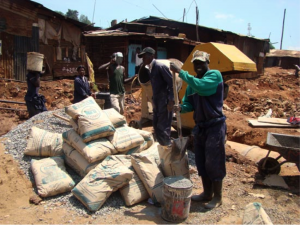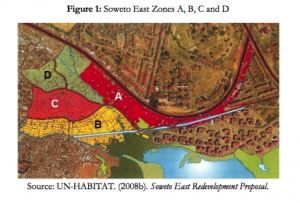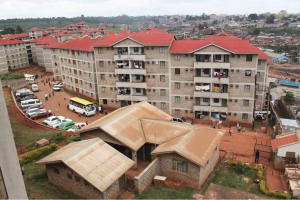By Ivy Wong
Part I: Growing Slums in Nairobi and Slum-Clearing Policies
Nairobi has had a history of slum-clearing and demolition policies and has recently adopted new initiatives towards slum-upgrading. Kenyan ministries have partnered with several organizations including the French Agency for Development (AFD), the World Bank, the Italian Development Cooperation, the Swedish International Development Cooperation Agency (SIDA) and the United Nations Human Settlements Programme (IFRA) (Syrjanen 2008).

The KENSUP program in action in Kibera: residents are taking part of the slum-upgrading program. (Image from Nextcity.org)
A new initiative that has grabbed the attention of many is the Kenyan Slum Upgrading Programme (KENSUP), a joint program between the Kenyan government and UN-Habitat that targets the Kibera slum as a pilot project. UN-Habitat, in their strategy document, reveals that they aim to create sustainable long term slum upgrading, harness political will, address inappropriate policies, implement appropriate services and even address social and health issues, such as HIV/AIDS. They will implement their goals through shelter development, installation of key infrastructure and servuces and through participatory preparation of the development plan (Syrjanen 2008). Kibera was chosen as the first place they would test this initiative on. Some accomplishments include the election of settlement executive committees, a creation of a draft master plan for Kibera, and the construction of 600 relocation houses. The KENSUP program started with Mavoko, Mombasa, Kisumi and Kibera but hopes to target all provincial headquarters and secondary towns with more than 20,000 people (UN-habitat).
The SIDA, AFD, and World Bank provided loans to develop Kenya Informal Settlement Program (KISIP). KISIP is a shorter program that lasts only five years and it focuses on infrastructure and land tenure. They aim to include participatory urban planning and to strengthen key institutions of urban management (Syrjanen 2008).
Both programs have already formed housing cooperatives in Kibera. UN-Habitat is successful in providing water through its Water and Sanitation program, sanitation and solid waste management in Kibera (Anderson et al 2013). Community participation has been adopted into both programs but they have not been strongly adopted; in fact, for programs that involve such a large amount of community participation, they don’t seem to be involving the residents a lot (Anderson et al. 2013). KISIP failed to utilize civil society organizations.

Zones A, B, C, and D represent Soweto Zones in Kibera. Residents of all these areas were relocated temporarily during the construction of the permanent relocation site. (Image from Nairobistudio.blogspot.org).
These slum-upgrading programs are great in terms of looking ahead for the future and aiming to better the conditions of slum dwellers. However, we must take into consideration the several challenges to slum upgrading. One would be the informality of slum settlements; slums have no formal tenure arrangements and their high densities and poor housing might pose some problems. There are also conflicts between tenants and landlords because of differing interests. The residents may also have a certain mistrust of the government and different initiatives due to past experiences. There is also a lack of space and of enough land for all the residents in slums, especially in informal settlements. Certain competing groups might also have their own interests in the slum, and might try to prevent slum upgrading in that area (Muraguri 2011). In Nairobi, rent constitutes a large part of the housing market and many low income residents would not be able to afford any of the housing that require rent. The only type of housing they could afford would be for council housing and dense multi-storey rooming districts, both which are either highly inaccessible or are unauthorized. The multi-story rooms that slum dwellers can afford are ones that are badly neglected by landlords (Huchzermeyer 2008).

About five thousand residents in Kibera were relocated to three room units, with one household per room. (Image from Nairobistudio.blogspot.org/Nairobi Studio Magazine).
Many different groups of people have prescribed their own solutions. Some say that we should focus on affordability and others think that access to housing is key. Some even believe that large-scale public housing should be erected. Even though there have been initiatives such as KENSUP and KISIP that try to improve the conditions of slum-dwellers, there are still many obstacles that need to be addressed and targeted. In a government that is highly corrupted and in a place where so many of the settlements are informally built, there are bound to be problems and things that will go wrong. The KENSUP and KISIP programs sound like two very hopeful plans for the future, and I hope that they will be successful in achieving their goals; however, they can only do this through a persistent struggle to overcome the obstacles and they must try their best make sure that no one falls through the cracks.
Bibliography
Anderson, Mark, and Keziah Mwelu. Center for Global Healthy Cities , “Kenyan Slum Upgrading Programs: KISIP and KENSUP.” Last modified March 10, 2013. Accessed November 17, 2013. http://healthycities.berkeley.edu/uploads/1/2/6/1/12619988/kenya.pdf.
Huchzermeyer, Marie. “Slum Upgrading in Nairobi within the Housing and Basic Services Market: A Housing Rights Concern.” Journal of Asian and African Studies. (2008): 19-39.
Muraguri, Leah. “Kenyan Government Initiatives in Slum Upgrading .” French Institute for Research in Africa. (2011): 119-128.
Syrjanen, Raakel. United Nations Humans Settlement Programme, “UN-HABITAT and the Kenya Slum Upgrading Programme Strategy Document.” Last modified 2008. Accessed November 17, 2013.
